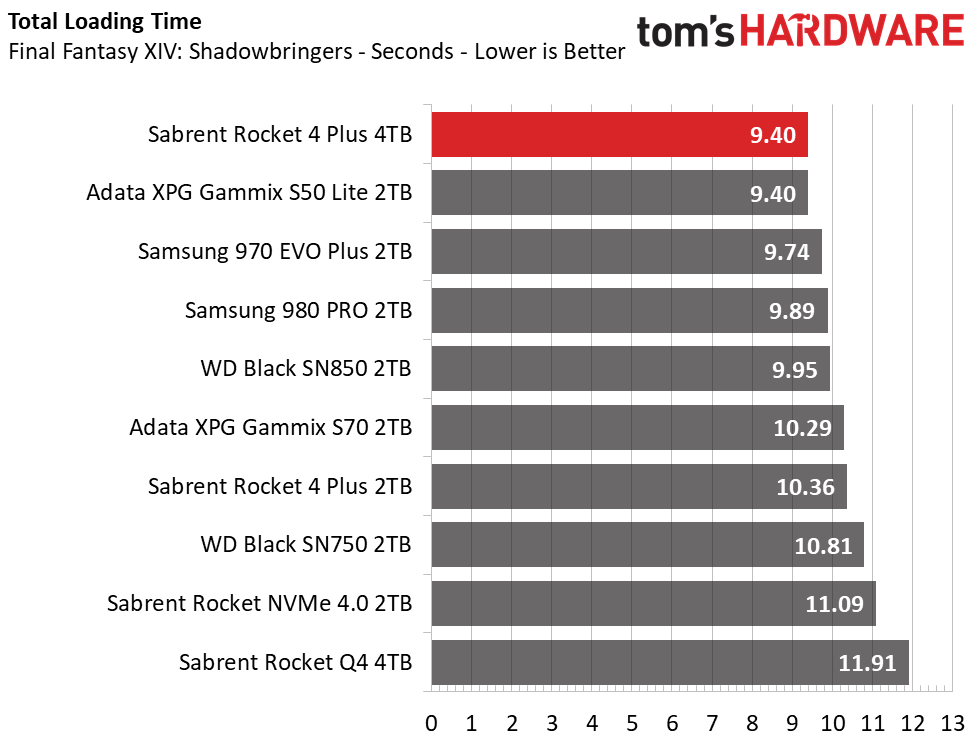Why you can trust Tom's Hardware
Comparison Products
We put the 4TB Sabrent Rocket 4 Plus against its smaller 2TB sibling, as well as the best SSDs from WD, Samsung, and a few others. We threw in a WD Black SN850, SN750, and Samsung’s 980 Pro and 970 EVO Plus. We also included the Sabrent Rocket Q4 and NVMe 4.0. Additionally, Adata’s XPG Gammx S70 and S50 Lite jump into the mix.
Game Scene Loading - Final Fantasy XIV
Final Fantasy XIV Shadowbringers is a free real-world game benchmark that easily and accurately compares game load times without the inaccuracy of using a stopwatch.
While the WD Black SN850 and Samsung 980 Pro are fast, Sabrent’s 4TB Rocket 4 Plus is faster in this game loading benchmark. The Sabrent takes first place, outperforming both by roughly 0.5s, and is nearly a second faster than its 2TB counterpart.
Transfer Rates – DiskBench
We use the DiskBench storage benchmarking tool to test file transfer performance with a custom dataset. We copy a 50GB dataset, including 31,227 files of various types, like pictures, PDFs, and videos, to a new folder and then follow-up with a reading test of a newly-written 6.5GB zip file.
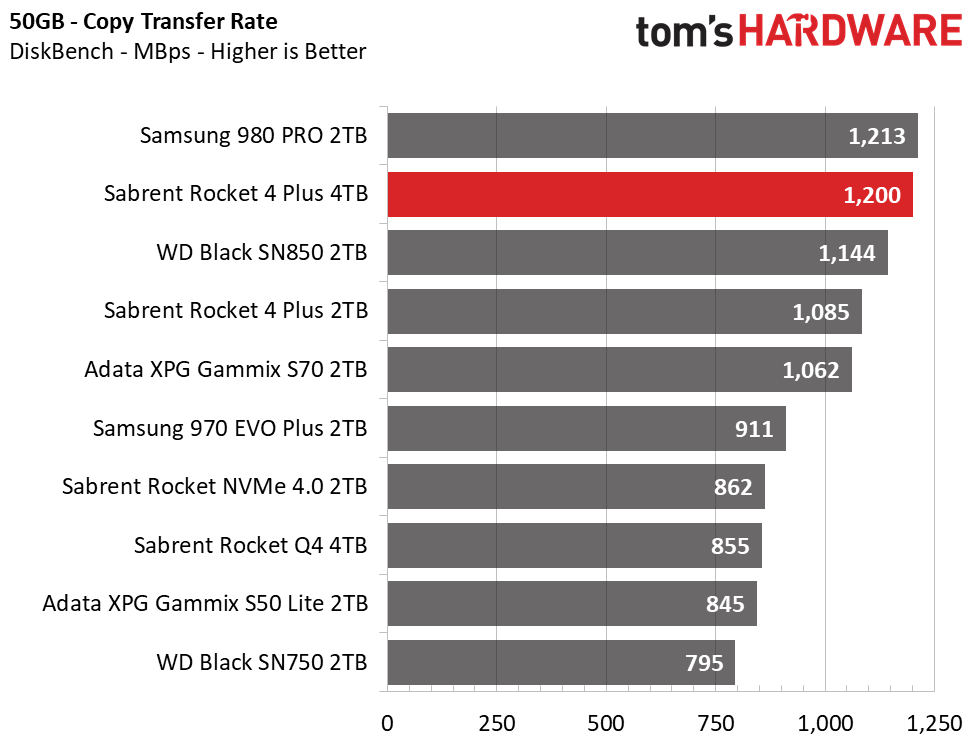
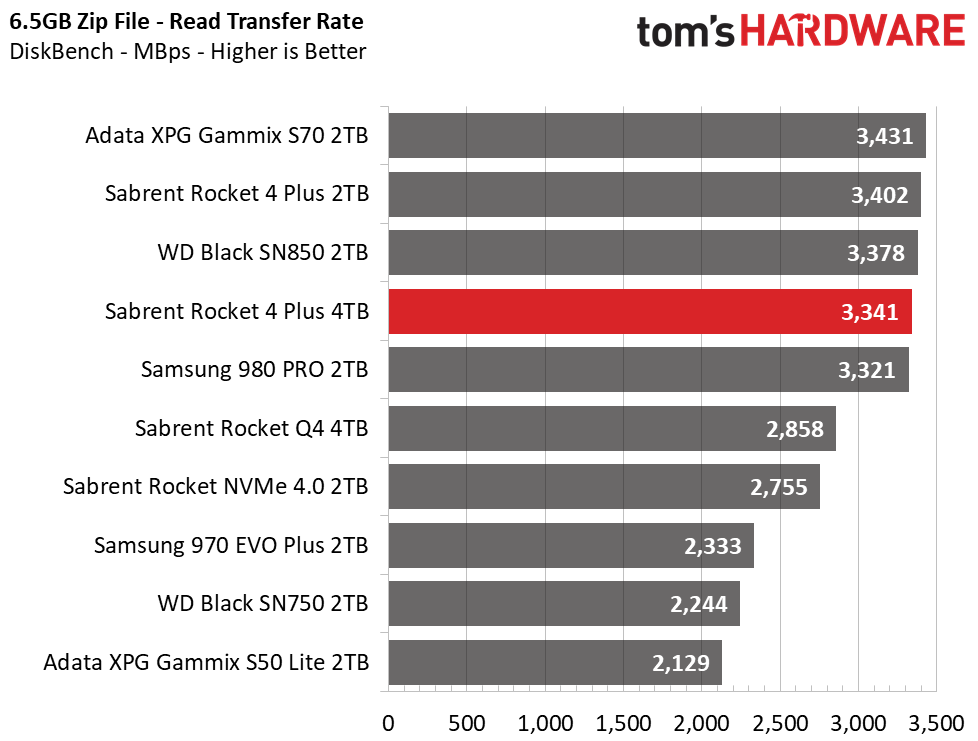
Outpaced only by Samsung’s 980 Pro, the Rocket 4 Plus takes second place in our file copy test thanks to its huge SLC cache. It takes fifth place when we read back the large files, which is just a hair slower than the fastest drive in the test pool.
Trace Testing – PCMark 10 Storage Test
PCMark 10 is a trace-based benchmark that uses a wide-ranging set of real-world traces from popular applications and everyday tasks to measure the performance of storage devices. The quick benchmark is more relatable to those who use their PCs for leisure or basic office work, while the full benchmark relates more to power users.
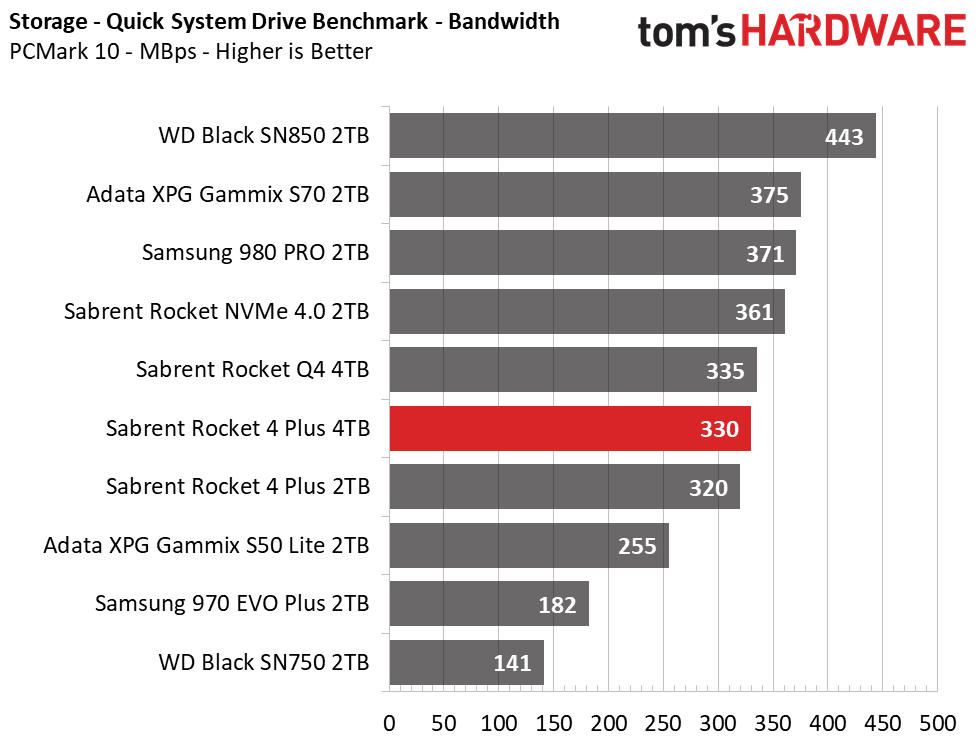
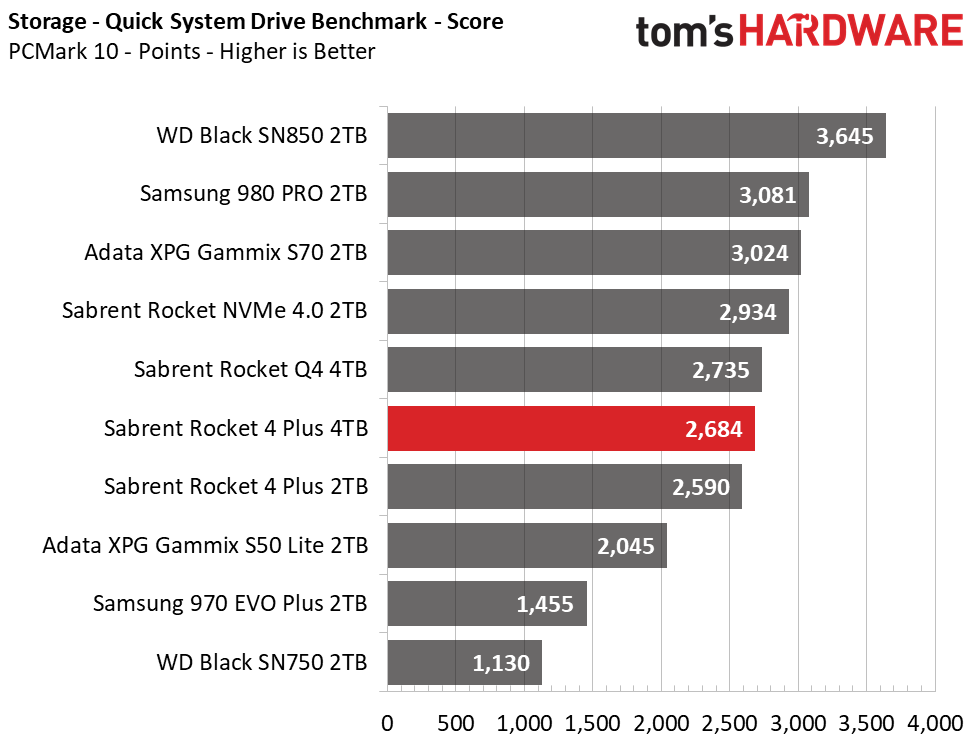
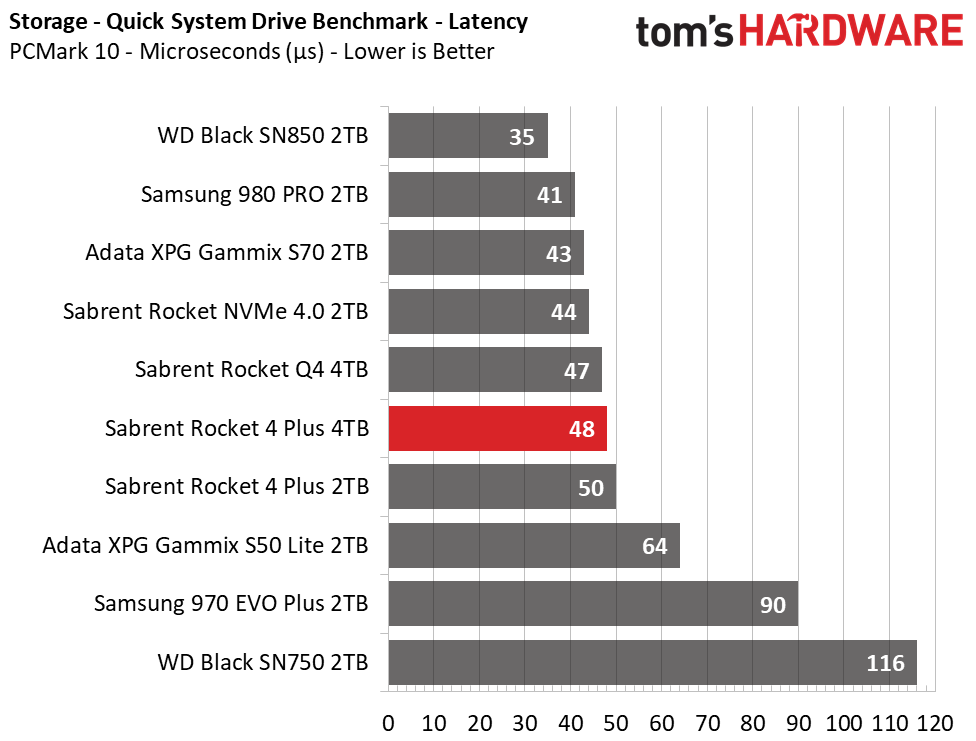
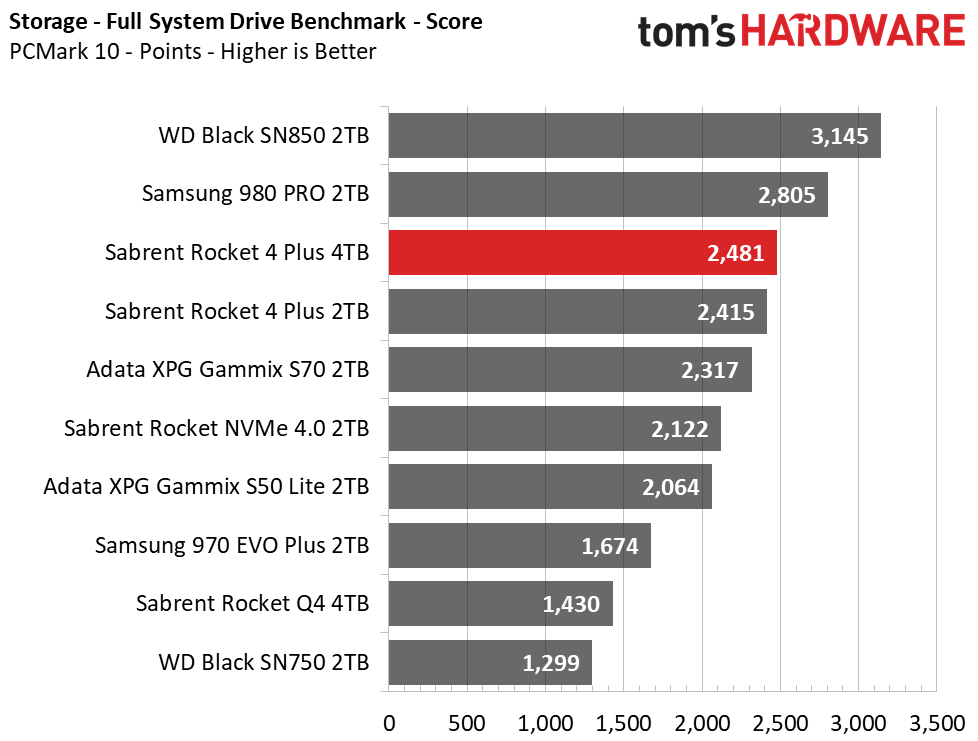
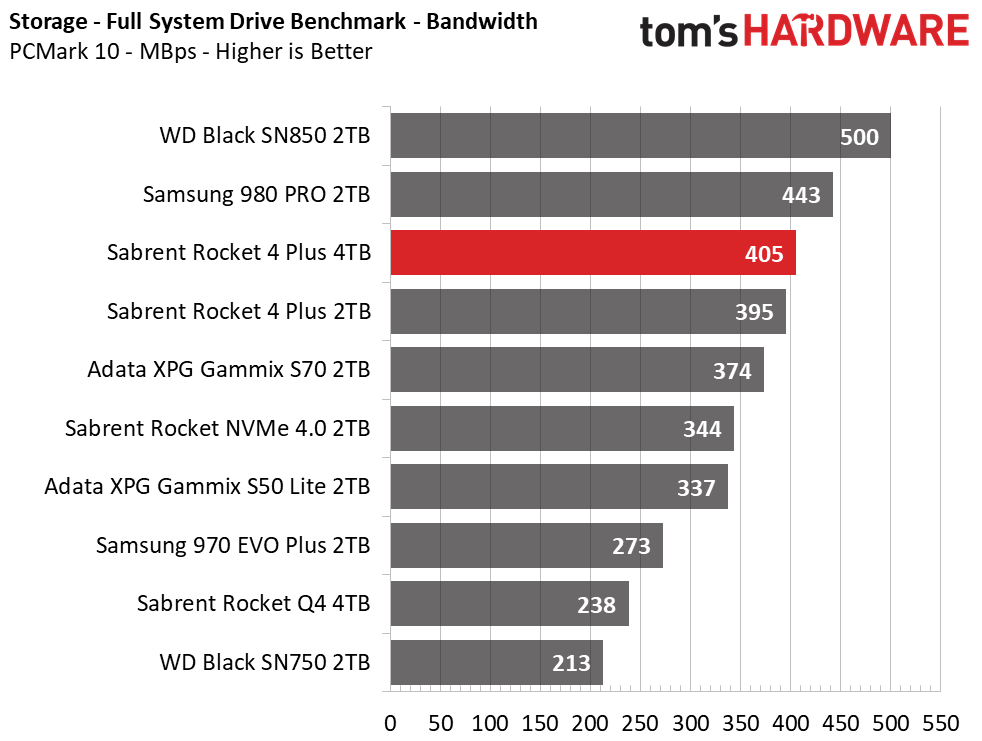
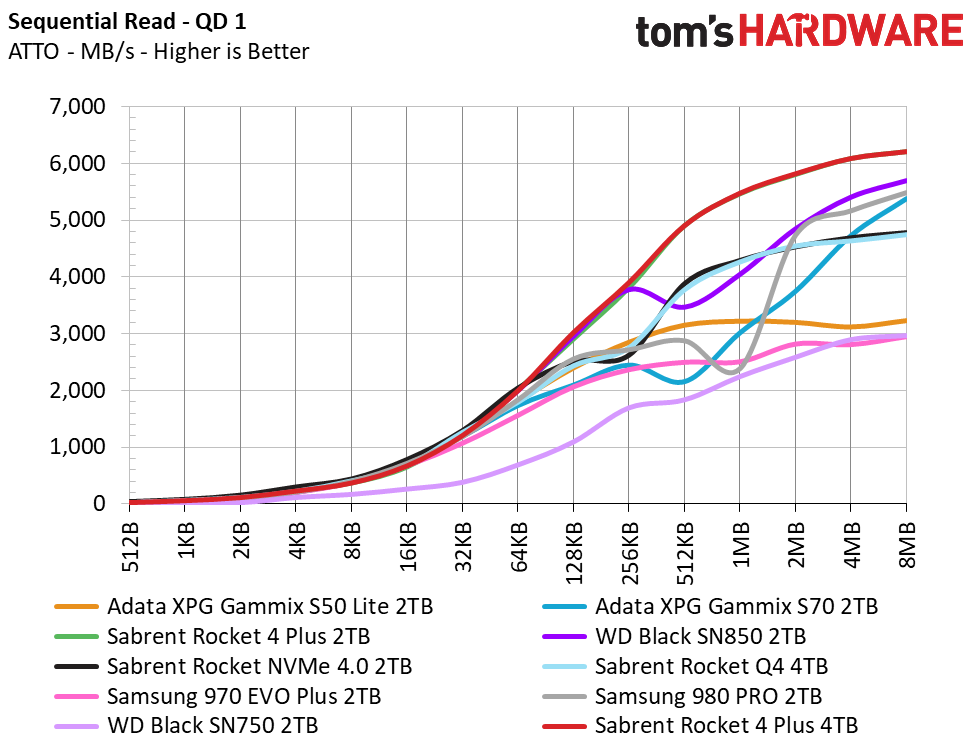
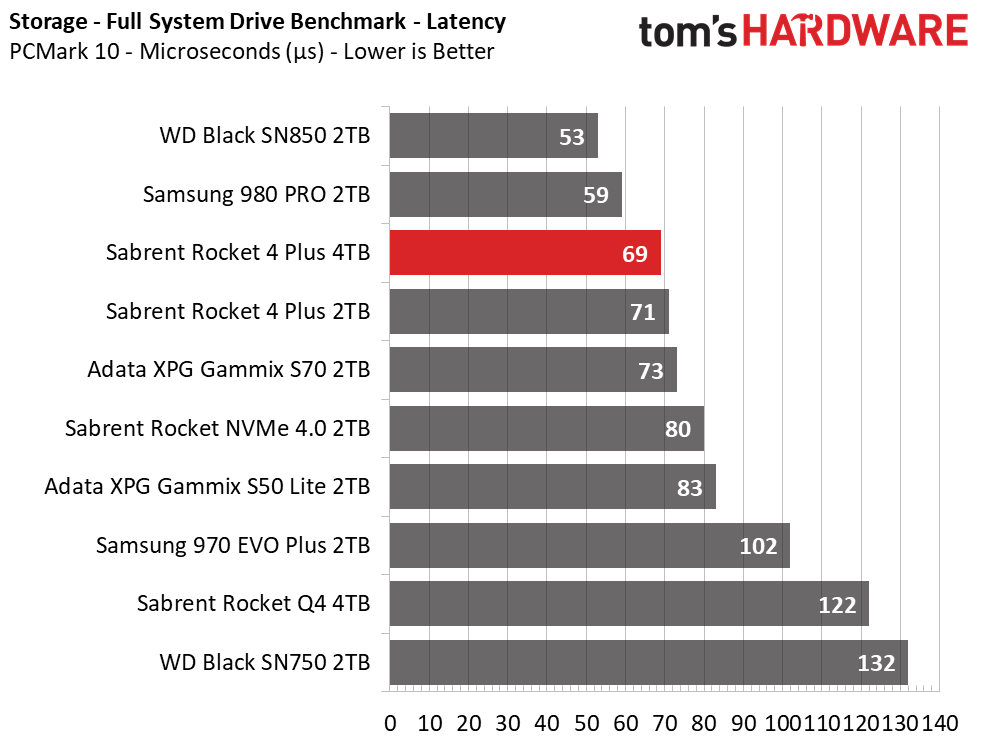
Sabrent’s 4TB Rocket 4 Plus delivers solid results in PCMark 10, outperforming its 2TB counterpart in both tests. It was especially impressive when we hit it with the Full System Benchmark, but it isn’t quite as responsive as the WD or Samsung Gen4 SSDs. Both the 980 Pro and WD Black SN850 deliver snappier performance during these realistic trace workloads.
Get Tom's Hardware's best news and in-depth reviews, straight to your inbox.
Synthetic Testing - ATTO / iometer
iometer is an advanced and highly configurable storage benchmarking tool while ATTO is a simple and free application that SSD vendors commonly use to assign sequential performance specifications to their products. Both of these tools give us insight into how the device handles different file sizes.

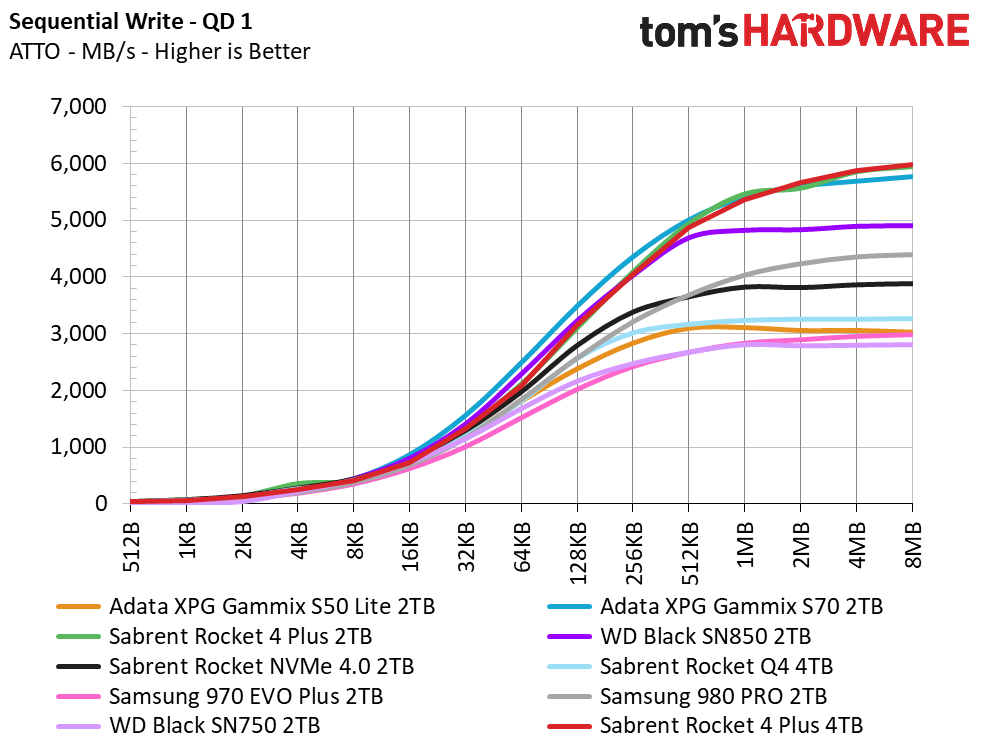

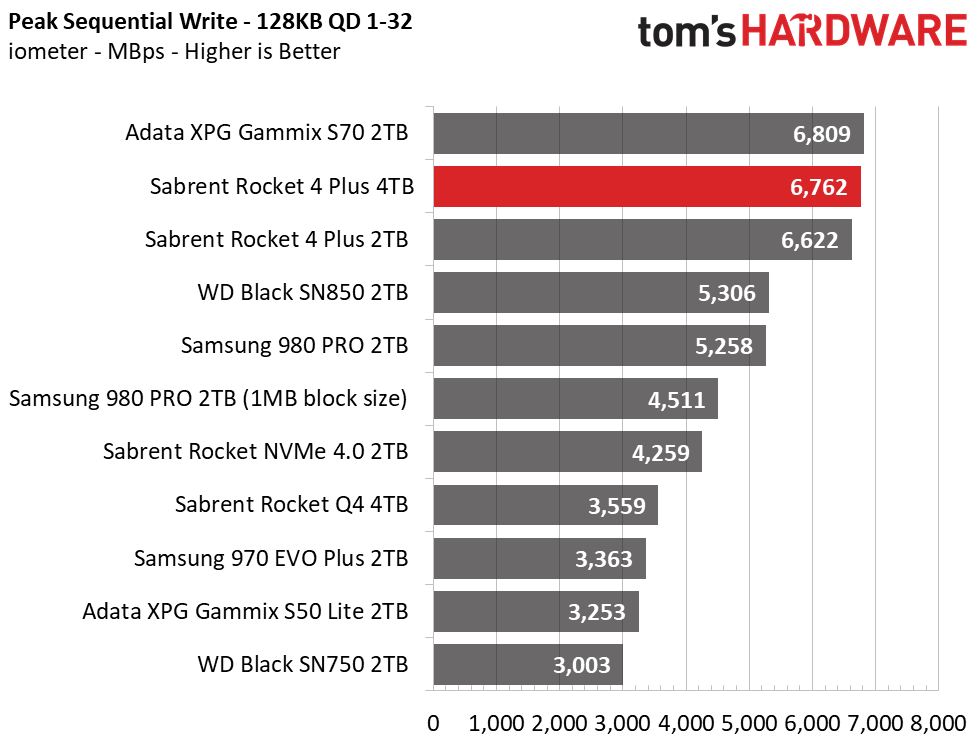
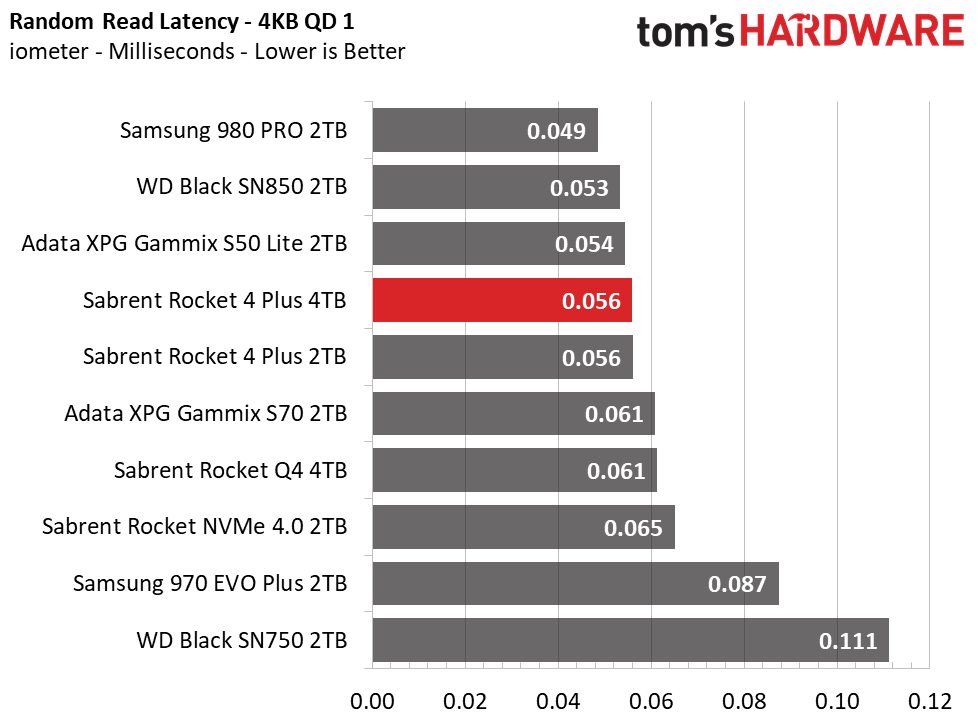
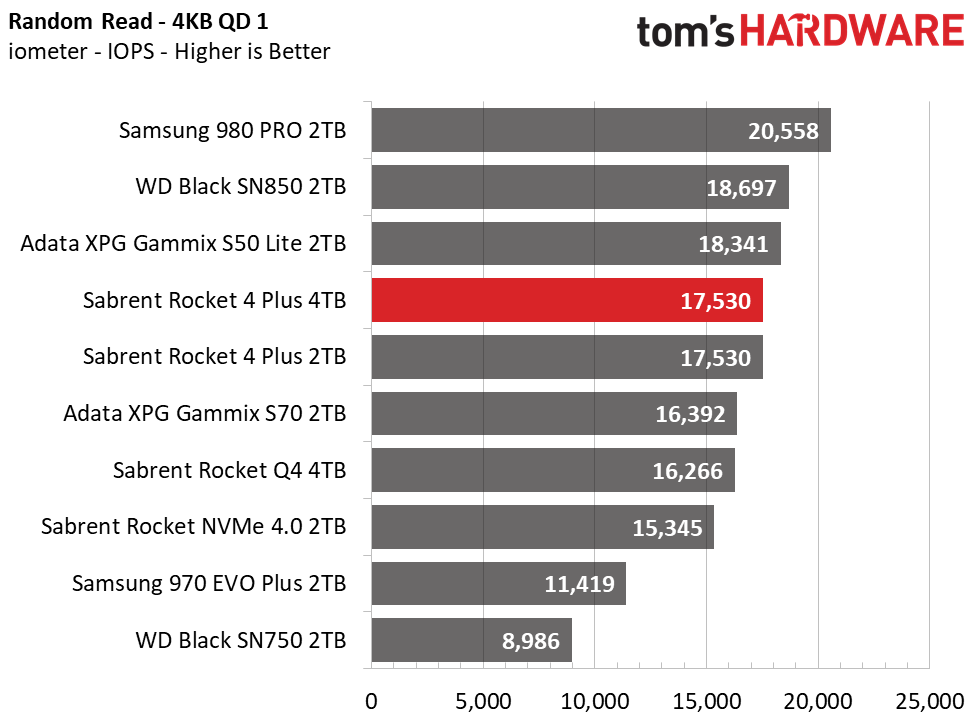
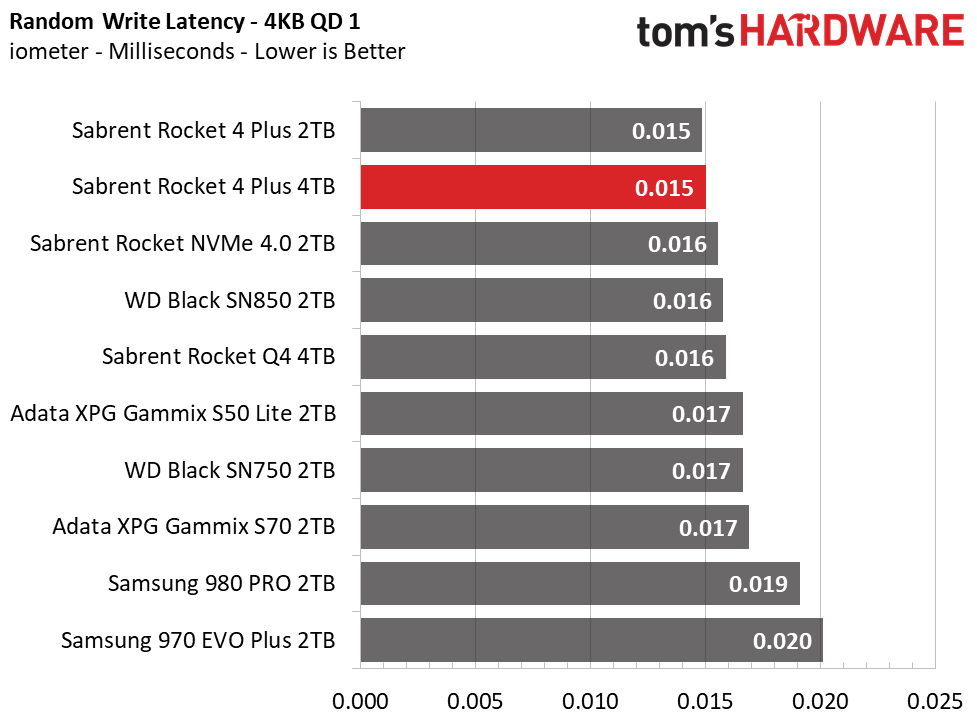
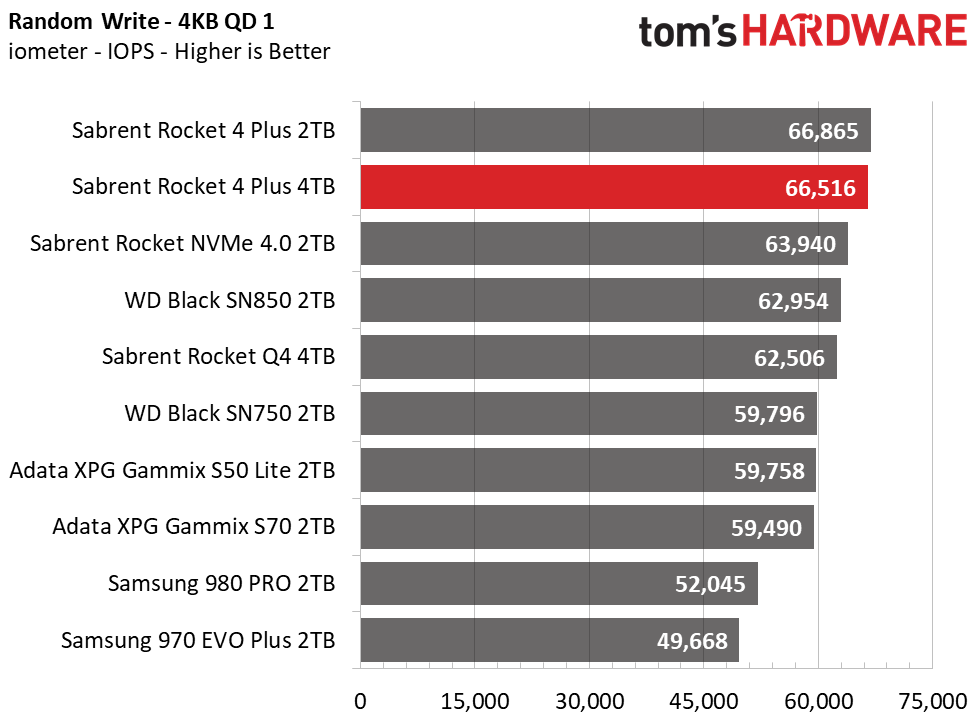
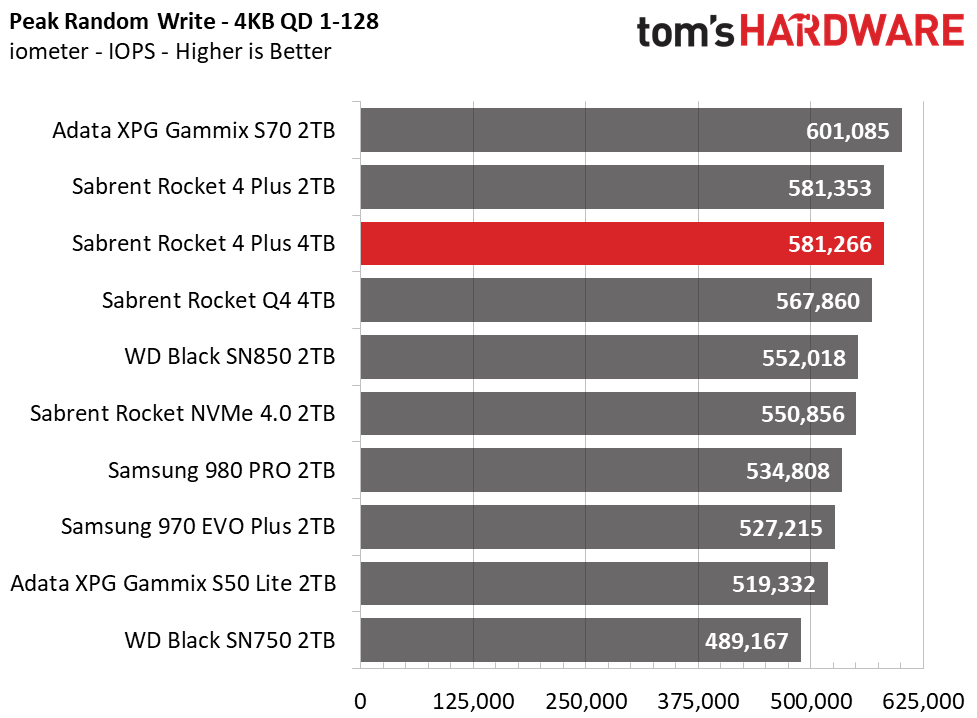

The Sabrent Rocket 4 Plus shows solid sequential performance across the board, scaling well with each file size at a QD of 1. We recorded peak read performance of 7.2 GBps with 1MB blocks, but only 7.05 GBps with 128KB blocks. The Rocket 4 Plus’s sequential write performance was also very strong and sustained roughly 6.8 GBps with both block sizes. The Rocket 4 Plus delivers some of the fastest random write results in our test pool, along with solid read results, but it isn’t as well-tuned as the WD Black SN850 or Samsung 980 Pro.
Sustained Write Performance and Cache Recovery
Official write specifications are only part of the performance picture. Most SSDs implement a write cache, a fast area of (usually) pseudo-SLC programmed flash that absorbs incoming data. Sustained write speeds can suffer tremendously once the workload spills outside of the cache and into the "native" TLC or QLC flash. We use iometer to hammer the SSD with sequential writes for 15 minutes to measure both the size of the write cache and performance after the cache is saturated. We also monitor cache recovery via multiple idle rounds.
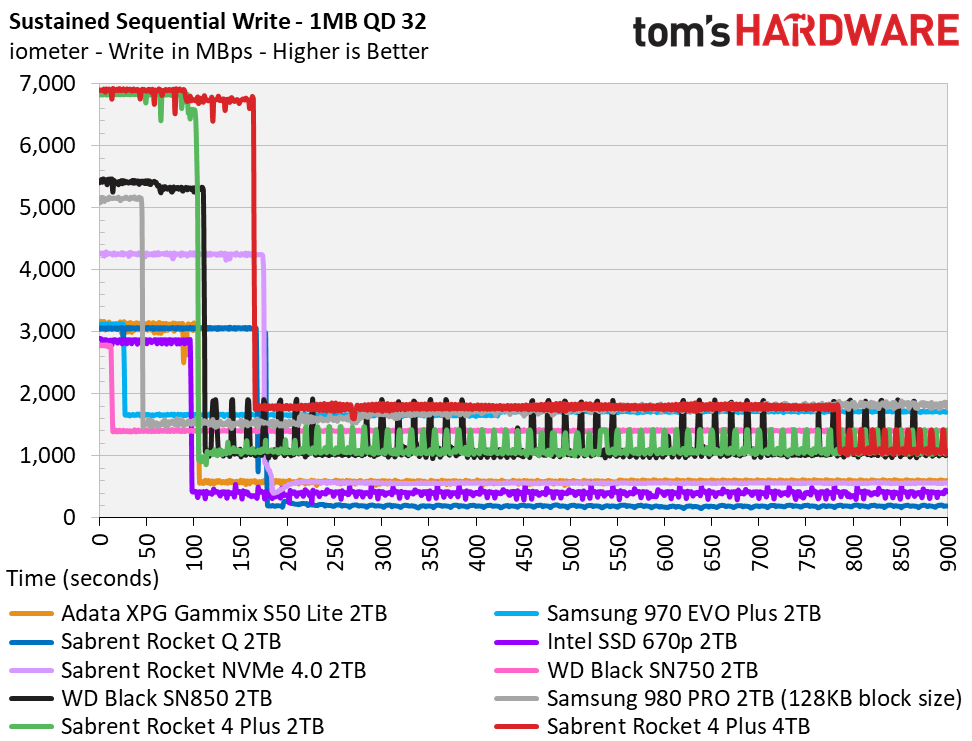
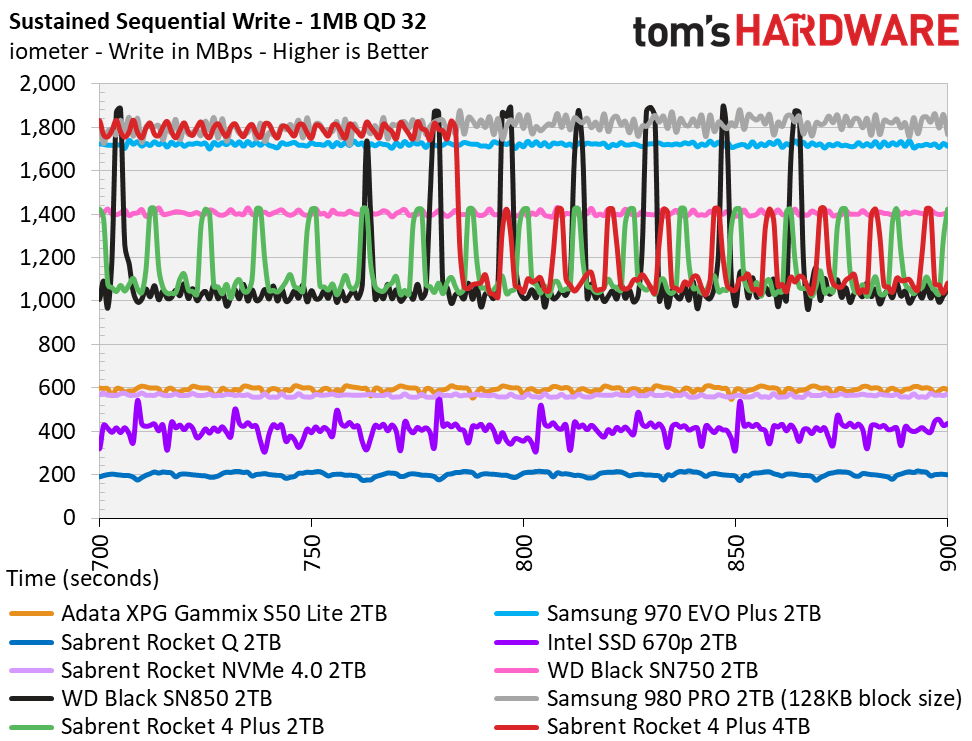
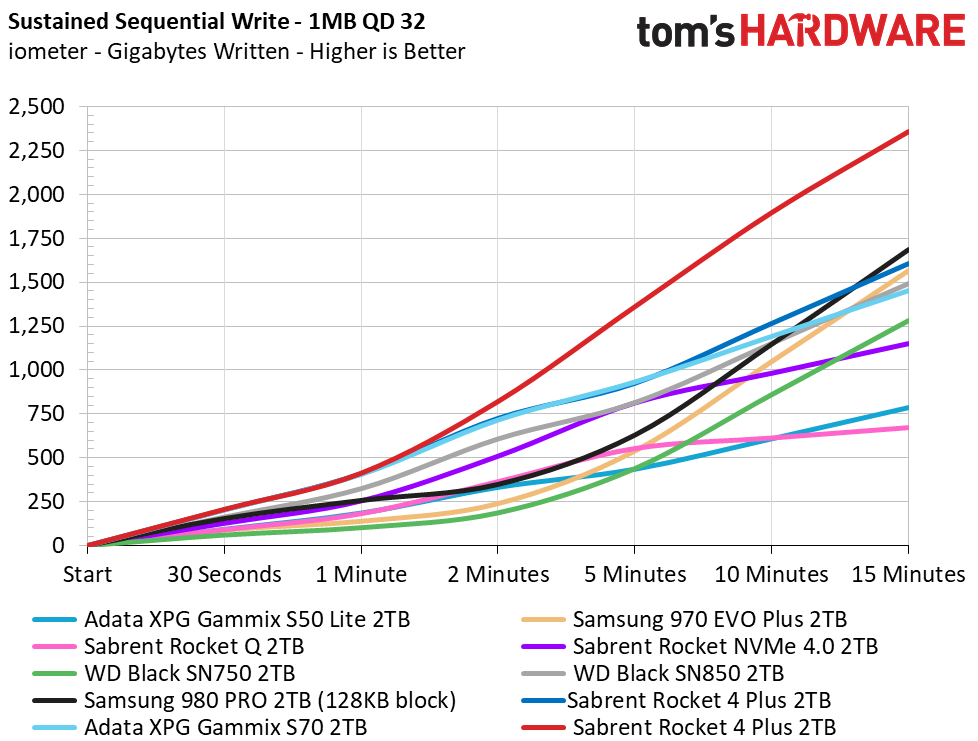
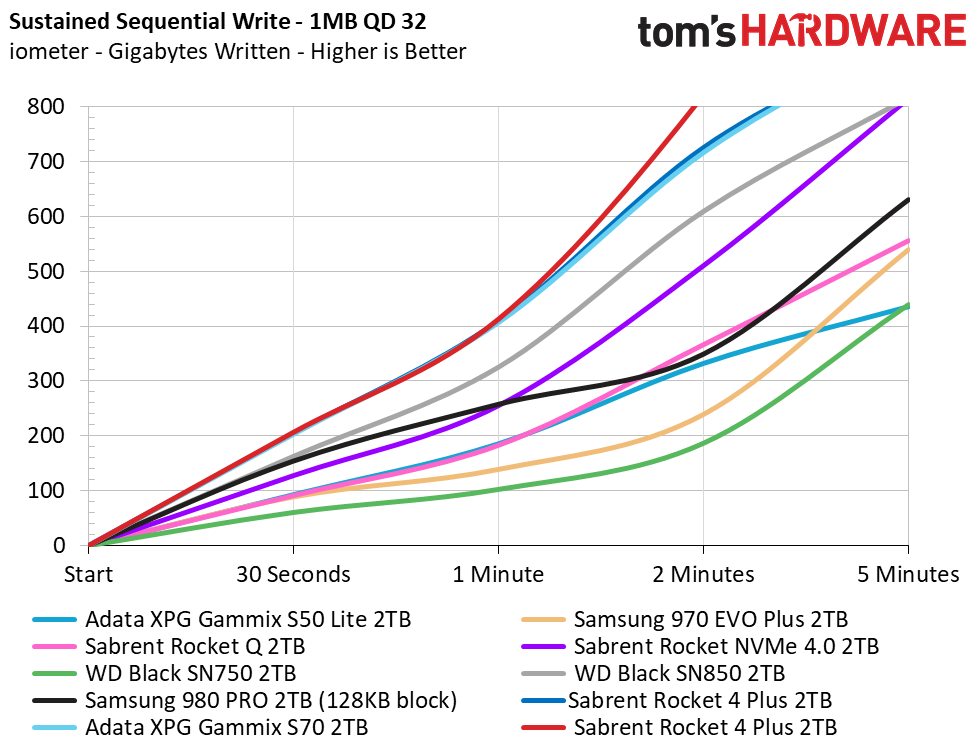
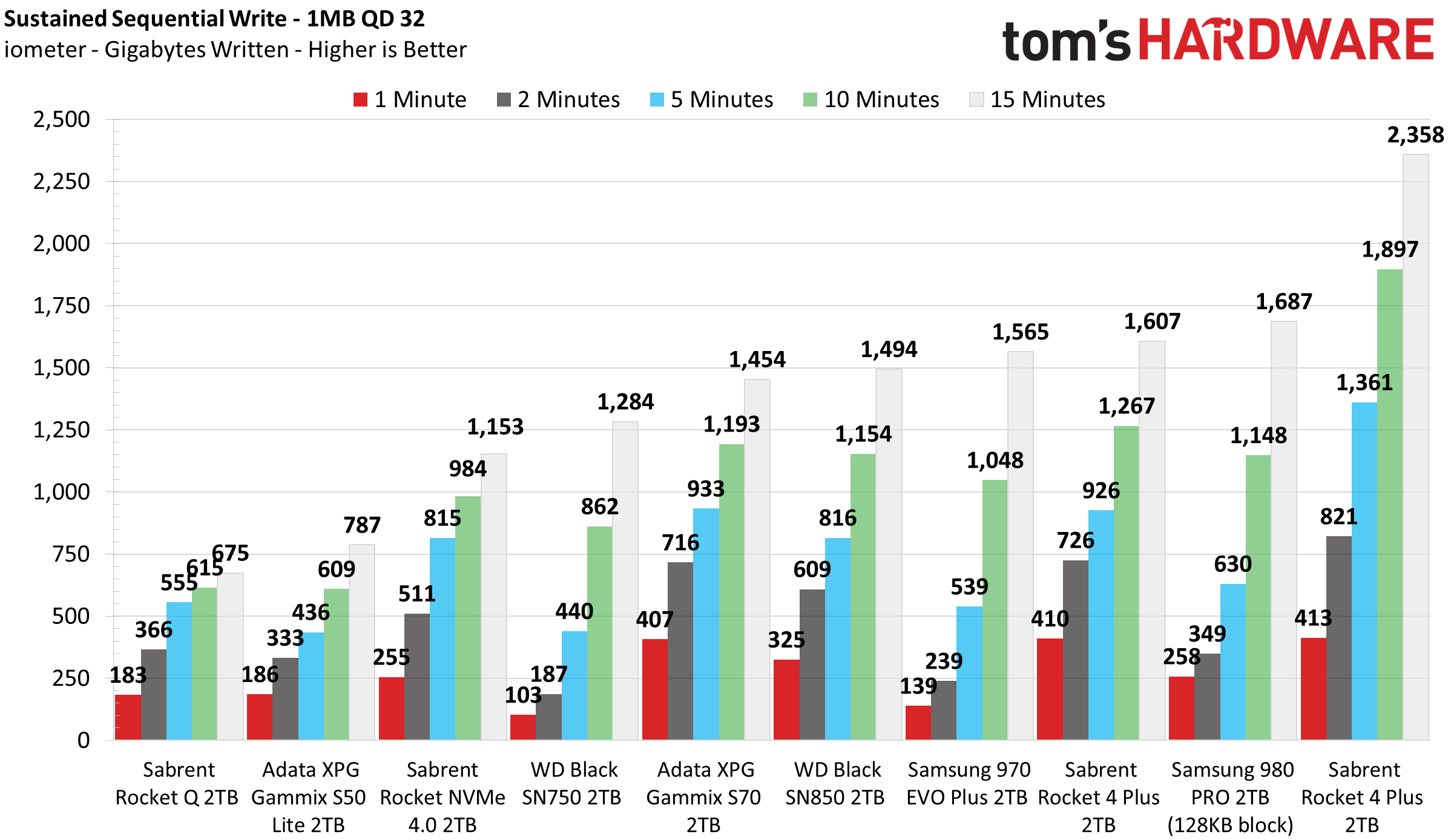
Sabrent’s 4TB Rocket 4 Plus is a writing monster. It wrote 1.12TB of data at 6.8 GBps before degrading to an average write speed of 1.8 GBps. After writing a total of 2.2TB of data, the Rocket 4 Plus’s write speed degraded once more, to 1.1GBps, for the remainder of the test. The SLC cache recovered very quickly — roughly 450GB within just a minute of idle time. However, to unlock this fast performance, we had to use a heatsink and two 120mm fans blowing on the SSD to keep it from throttling while absorbing the large write workload.
Power Consumption and Temperature
We use the Quarch HD Programmable Power Module to gain a deeper understanding of power characteristics. Idle power consumption is an important aspect to consider, especially if you're looking for a laptop upgrade. Some SSDs can consume watts of power at idle, while better-suited ones sip just milliwatts. Average workload power consumption and max consumption are two other aspects of power consumption, but performance-per-watt is more important. A drive might consume more power during any given workload, but accomplishing a task faster allows the drive to drop into an idle state more quickly, ultimately saving energy.
We also monitor the drive’s temperature via the S.M.A.R.T. data and an IR thermometer to see when (or if) thermal throttling kicks in and how it impacts performance. Bear in mind that results will vary based on the workload and ambient air temperature.

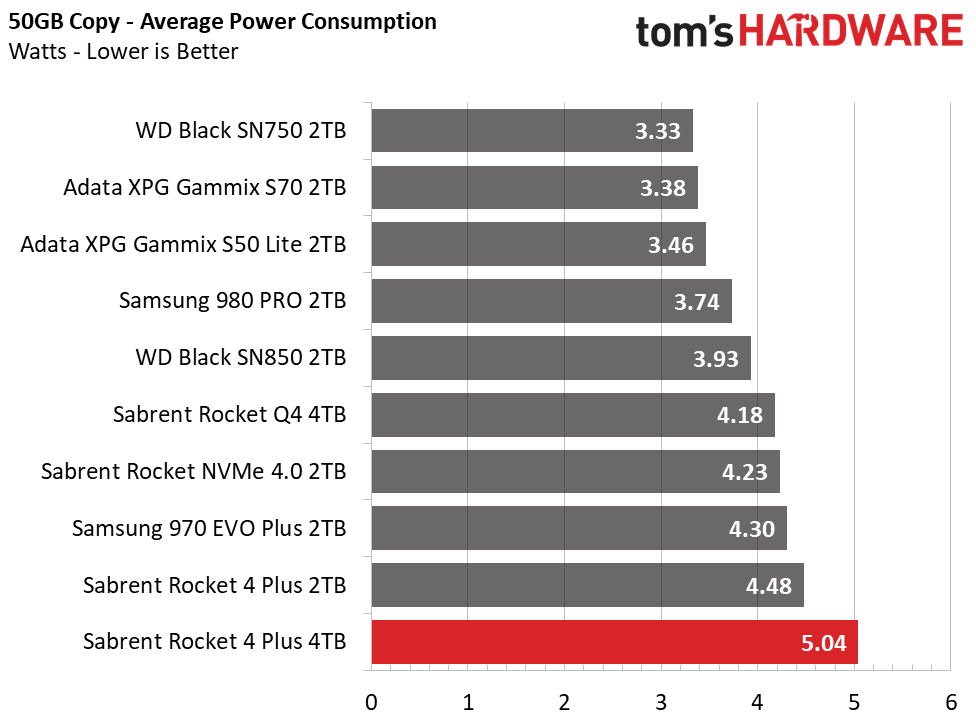
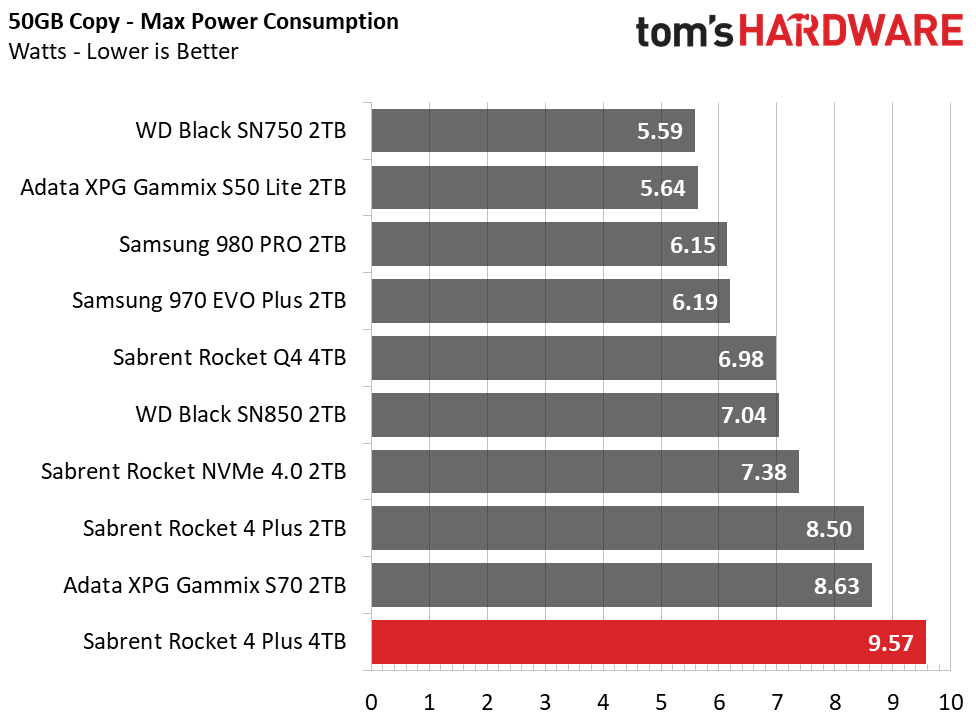
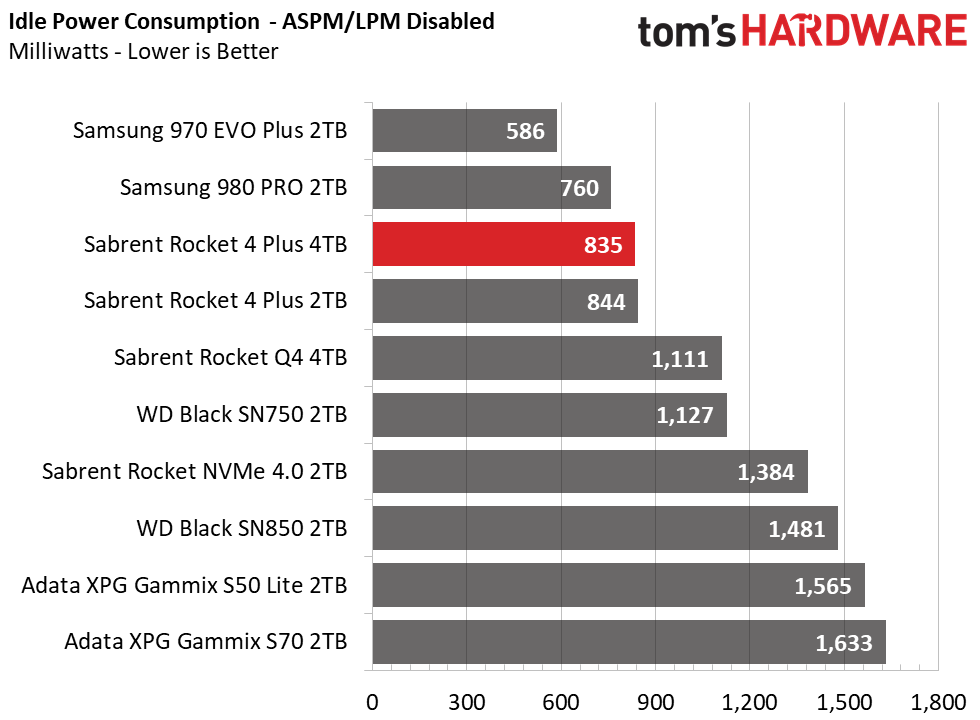
At 4TB, there’s a lot of flash packed onto this small M.2 SSD. That has a downside, though; due to that immense amount of storage, the device can consume a lot of power. We tested for efficiency under load, and the drive sucked an average of half a watt more than the 2TB model and peaked at over a watt higher while scoring similar efficiency due to added performance improvement. However, this leads to very high heat output and throttling when you load the drive with heavy writes.
Without a heatsink or active cooling, idle temperatures measured roughly 40C in our 23C lab, but you’ll need additional cooling if you plan on hammering the drive. The included copper label isn’t enough to offset the high average power consumption, especially when we taxed the drive with multiple write transfers from another NVMe SSD. The SSD began to throttle, and performance degradation set in once S.M.A.R.T. data reported peak temperatures of 79C after we had transferred roughly 400GB of data.
MORE: Best SSDs
MORE: How We Test HDDs And SSDs
MORE: All SSD Content
Current page: 4TB Performance Results
Prev Page Features and Specifications Next Page 2TB Performance Results
Sean is a Contributing Editor at Tom’s Hardware US, covering storage hardware.
-
Alvar "Miles" Udell Remember when Samsung drives were the fastest AND the cheapest? 2021 and still well above the $100/TB level...Reply -
Chris Fetters Spends much of the review (& most of the conclusion) talking about how the 2TB model is able to get significantly more performance out of the new Phison E18 controller and as such, THAT'S the one you should buy... to then go and EXCLUSIVELY only show benchmark results of the 1TB drive in the review itself... -_- ... I am not amused.Reply -
seanwebster Reply
I reviewed both capacities at once, but the 2TB results will show in an update soon, painting a better picture.Chris Fetters said:Spends much of the review (& most of the conclusion) talking about how the 2TB model is able to get significantly more performance out of the new Phison E18 controller and as such, THAT'S the one you should buy... to then go and EXCLUSIVELY only show benchmark results of the 1TB drive in the review itself... -_- ... I am not amused. -
prolfe Reply
Sean,seanwebster said:I reviewed both capacities at once, but the 2TB results will show in an update soon, painting a better picture.
It sounds like you're saying you did all the work required to make a complete review, but decided to hold some back and get a second article out of it for those sweet sweet clicks. I'm a longtime toms reader and that won't change anytime soon. Also note that I didn't accuse you but rather said it sounds like a certain thing. If I'm correct it does sound a little shady. You didn't call the article "Rocket 4 Plus 1 TB Review" and didn't mention anywhere in the article that there was more data for the 2 TB coming. Also, it's not like the 2TB isn't out yet, so you can't say you're holding it back til the 2 TB comes out. I appreciate your work and thank you for writing this article. Please take the comment in the spirit it is given: as constructive criticism of a potential business practice that I personally find distasteful. I hope you'll consider refraining from this in the future. -
seanwebster Reply
I typically review one capacity at a time and then release another capacity at a later date because it takes longer to test. The 2TB's results were mostly done when I wrapped up the review, but I was having a little trouble with something, hence the delay. But, since the 2TB results will be published soon, and again, I already had the majority of my data, I wrote the conclusion based on both capacities from the getgo.prolfe said:Sean,
It sounds like you're saying you did all the work required to make a complete review, but decided to hold some back and get a second article out of it for those sweet sweet clicks. I'm a longtime toms reader and that won't change anytime soon. Also note that I didn't accuse you but rather said it sounds like a certain thing. If I'm correct it does sound a little shady. You didn't call the article "Rocket 4 Plus 1 TB Review" and didn't mention anywhere in the article that there was more data for the 2 TB coming. Also, it's not like the 2TB isn't out yet, so you can't say you're holding it back til the 2 TB comes out. I appreciate your work and thank you for writing this article. Please take the comment in the spirit it is given: as constructive criticism of a potential business practice that I personally find distasteful. I hope you'll consider refraining from this in the future. -
Makaveli Not liking the endurance drop from E16 drives at 1TB that do 1,800 TBW to now 700TBW.Reply
also the E16 Corsair MP600 has AES 256-bit encryption.
Waiting for your review of the Corsair Core and Pro models. -
prolfe Reply
Thanks for the explanation and glad to hear it was something completely understandable. You keep making good articles and I'll keep reading!seanwebster said:I typically review one capacity at a time and then release another capacity at a later date because it takes longer to test. The 2TB's results were mostly done when I wrapped up the review, but I was having a little trouble with something, hence the delay. But, since the 2TB results will be published soon, and again, I already had the majority of my data, I wrote the conclusion based on both capacities from the getgo. -
RedCat888 (HIGUYS9090) ReplyAlvar Miles Udell said:Remember when Samsung drives were the fastest AND the cheapest? 2021 and still well above the $100/TB level...
I mean you can get a 1TB NVME for $100, and even a 1TB sata drive for 80-90 bucks, it's just that the increase in speed makes it more expensive -
thdm Nice review update. I'd been looking at the 2TB Rocket 4 plus for a little while.Reply
My interest in this SSD was at least in part because I was planning to run it in a laptop (MacBook Pro 2015) and being PCIe 3.0 was hoping that even though it's overkill and has more cores driving high performance for PCIe 4.0, that being a 12nm finfet design fabbed at TSMC that it might pull off nicely reduced overall power than other solutions for PCIe3.0.
The Sabrent site seems to indicate one needs a heatsink if running with a PCIe4.0 board, implying PCIe3.0 does/might not?
Any chance you can run some comparisons on PCIe3.0 with power consumption numbers? One would hope that it beats at least well proven PCIe3.0 designs on 28nm -
escksu ReplyChris Fetters said:Spends much of the review (& most of the conclusion) talking about how the 2TB model is able to get significantly more performance out of the new Phison E18 controller and as such, THAT'S the one you should buy... to then go and EXCLUSIVELY only show benchmark results of the 1TB drive in the review itself... -_- ... I am not amused.
IMHO, don't go too crazy over benchmarks. Unless you have more than 1 drive in your system, you will only be either transferring from/to RAM or another partition within the same drive.
You won't find windows or your apps loading much faster than even PCIE 3.0 drive (itself isn't really alot faster than SATA in daily usage cases.).
